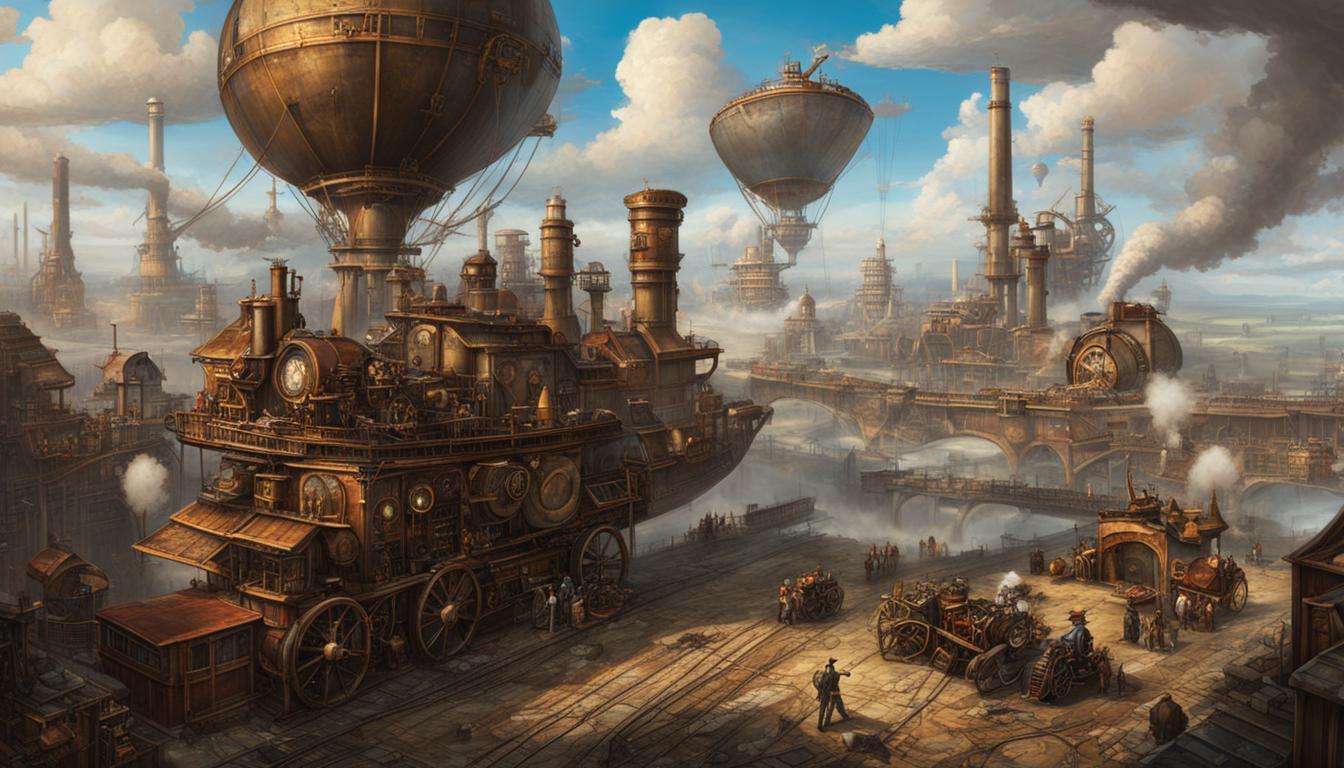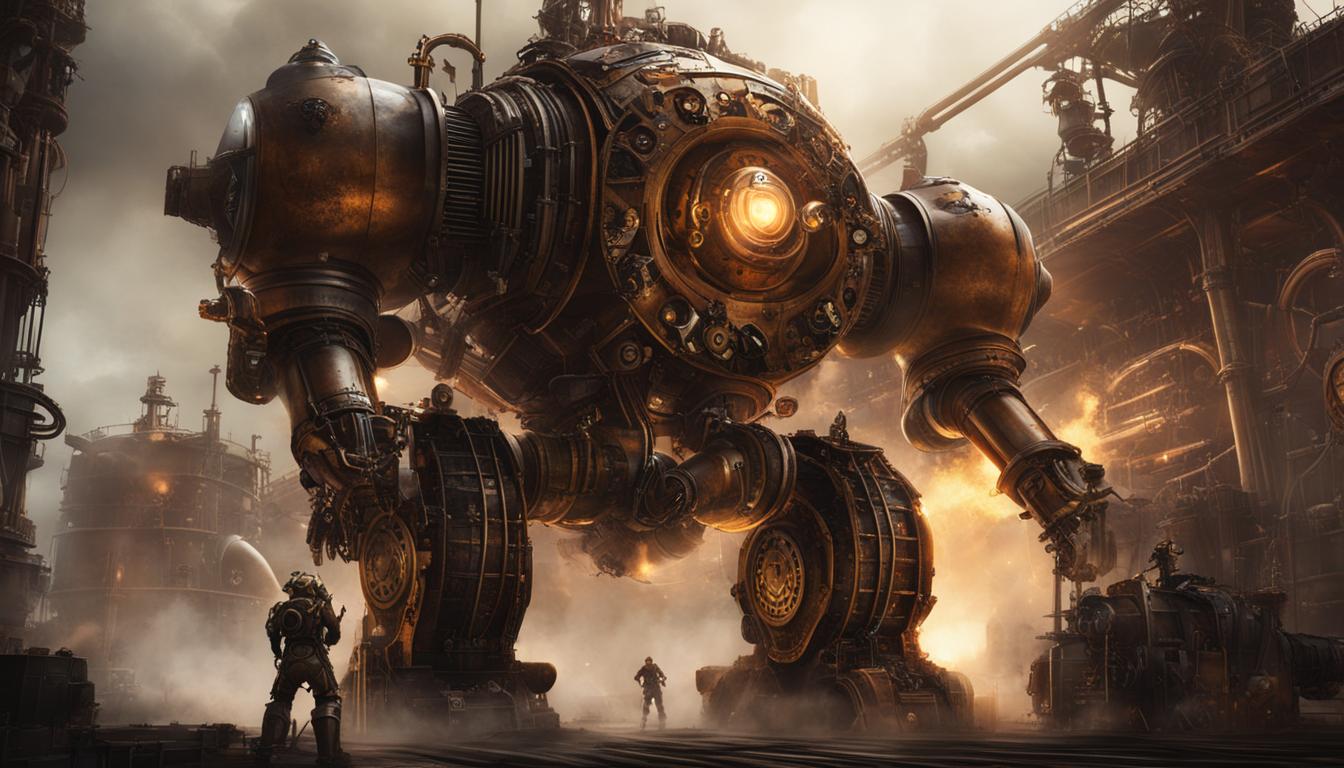In a world driven by cutting-edge technology and innovative solutions, one might assume that steam technology belongs to a bygone era. However, the modern age has witnessed a remarkable revival of this seemingly antiquated power source. With contemporary applications and modern innovations, steam technology is making a captivating comeback, defying expectations and capturing the imagination of engineers and enthusiasts alike.
Key Takeaways:
- Steam technology is experiencing a resurgence in the modern era.
- Contemporary applications of steam technology offer numerous advantages.
- Modern innovations have addressed the limitations of traditional steam power.
- Steam engines are being developed for various industries and forms of transportation.
- The integration of steam technology in modern devices shows promising potential.
Advances in Steam Technology Throughout the 20th Century
Throughout the 20th century, significant advancements were made in steam technology, leading to improvements in steam traction and efficiency. Innovators like Abner Doble, Sentinel Waggon Works, and Anderson and Holcroft played a crucial role in pushing the boundaries of steam technology.
One notable advancement was the development of automatic boiler control and rapid startup, pioneered by Abner Doble in 1922. His electro-mechanical system reacted to steam temperature and pressure, resulting in more efficient operation. This innovation marked a significant improvement in steam traction and set the stage for further advancements.
Sentinel Waggon Works in the UK also made significant contributions to steam technology with their vertical water-tube boiler, which allowed for faster steam generation. This development addressed one of the key limitations of traditional steam engines, further improving their overall efficiency and performance. These advancements in steam traction were pivotal in expanding the capabilities of steam technology.
“Advancements in steam technology throughout the 20th century have paved the way for the modern revival of steam in various industries.”
Trials of the Anderson condensing system on the Southern Railway showcased the potential advantages of improved thermal efficiency, reduced water consumption, reduced boiler maintenance, and reduced noise. This breakthrough not only enhanced steam traction but also made steam technology more environmentally friendly and sustainable.
These advancements in steam technology throughout the 20th century laid the foundation for further developments and set the stage for the resurgence of steam in the modern era. The innovative work of individuals like Abner Doble, Sentinel Waggon Works, and Anderson and Holcroft paved the way for the contemporary applications and innovations in steam technology we see today.
| Advancements | Contributors |
|---|---|
| Automatic boiler control and rapid startup | Abner Doble |
| Vertical water-tube boiler | Sentinel Waggon Works |
| Anderson condensing system | Anderson and Holcroft |
Influence of André Chapelon and Livio Dante Porta
The work of French mechanical engineer André Chapelon and his protégé Livio Dante Porta played a significant role in advancing steam technology. Chapelon’s focus on scientific analysis and thermal efficiency paved the way for modern steam innovations. Porta continued Chapelon’s work post-war and focused on modernizing steam locomotives. Their contributions influenced the design and development of steam engines, including the use of advanced technology and improved efficiency. Their work has had a lasting impact on the modern steam industry.

André Chapelon, known as the “Father of Modern Steam,” revolutionized steam locomotive design with his meticulous approach to engineering. He believed that improving the efficiency of steam locomotives was essential for their survival in the age of diesel and electric power. Chapelon’s innovations focused on optimizing boiler and engine performance to maximize thermal efficiency and reduce fuel consumption.
Livio Dante Porta, inspired by Chapelon’s work, continued to refine and expand upon the principles laid out by his mentor. Porta dedicated his career to modernizing steam locomotives and pushing the boundaries of what was thought possible with steam technology. His advancements included the development of the Lempor exhaust system, which dramatically improved the efficiency of steam engines by reducing exhaust losses.
“The Lempor exhaust system is the most important development in steam engineering since Chapelon’s era, making possible the operation of steam locomotives that are more efficient than diesels.” – Dr. William F. Chapman, mechanical engineer and steam locomotive expert
The influence of Chapelon and Porta can be seen in the modern steam industry, where their ideas continue to inspire engineers and enthusiasts alike. Their innovations have paved the way for the revival of steam technology in various applications, from heritage railways to advanced steam locomotives designed for modern transportation needs. The legacy of Chapelon and Porta lives on, ensuring that steam power remains a relevant and promising technology in the modern era.
The Role of Steam Power in the Industrial Revolutions
Steam power played a crucial role in the industrial revolutions, driving significant advancements and transforming industries across the globe. During the first industrial revolution, steam engines powered a wide range of industries, revolutionizing agriculture, transportation, and textile manufacturing. The introduction of steam-powered machinery allowed for faster and more efficient production, leading to unprecedented economic growth. As steam technology continued to evolve, the second industrial revolution witnessed the emergence of scientific advancements and mass production, which brought forth inventions like the gasoline engine and airplanes.
One of the key reasons for the widespread adoption of steam power was its ability to harness the energy of various fuel sources. Steam engines were initially fueled by coal, a readily available and abundant resource during the 18th and 19th centuries. The demand for coal grew exponentially as steam power became increasingly integrated into industries, leading to the expansion of mining operations and the development of transportation infrastructure to transport coal to power plants.
“Steam power was the driving force behind the production of commodities on a large scale, increasing the demand for raw materials and contributing to societal transformations.”
The use of steam power in industrial revolutions had a direct impact on the demand for raw materials. As industries expanded and production processes became more efficient, the need for raw materials such as iron, steel, and cotton grew exponentially. The mining, manufacturing, and transportation industries experienced significant growth as they catered to the demand for these essential resources. Steam-powered machinery and transportation systems enabled the extraction, processing, and distribution of raw materials on a scale never seen before, fueling the rapid industrialization of nations.
| Industrial Revolution | Main Innovations | Impact |
|---|---|---|
| First Industrial Revolution (late 18th to early 19th century) | Steam engine, mechanized textile production | Transformation of agriculture and textile manufacturing, rise of factories and urbanization |
| Second Industrial Revolution (late 19th to early 20th century) | Scientific advancements, mass production, gasoline engine | Introduction of new technologies, expansion of transportation and communication networks |
| Third Industrial Revolution (late 20th century) | Digital technology, automation, renewable energy | Shift towards digitalization and automation, focus on sustainability and renewable energy sources |
The integration of steam power into industries during the industrial revolutions not only revolutionized production processes but also had profound societal and economic implications. It laid the foundation for the modern era of manufacturing, transportation, and energy production, shaping the world as we know it today.
Integrating Steam Technology in the Modern Era
In the modern era, steam technology is making a remarkable comeback, finding its place in various devices and applications. It offers a range of contemporary uses that have captured the attention of industries around the world. From stationary power generation to transportation and manufacturing, steam technology is proving to be a versatile and efficient choice.
One of the key contemporary applications of steam technology is in stationary power generation. Steam engines have been adapted and optimized to generate electricity, providing a clean and reliable source of energy. Their ability to harness diverse heat sources and waste heat makes them an attractive option for modern power generation needs.
Another area where steam technology is flourishing is in transportation. Steam engines are being developed for road vehicles, rail transportation, and marine vessels. These advancements result in improved traction, higher thermal efficiency, and reduced pollution. As a result, steam technology is being considered as a viable alternative to traditional power sources, offering a sustainable solution in the modern age.
| Applications of Steam Technology | Advantages |
|---|---|
| Stationary Power Generation | – Clean and reliable energy source – Adaptability to various heat sources |
| Road Vehicles, Rail Transportation, and Marine Vessels | – Improved traction – Higher thermal efficiency – Reduced pollution |

Steam technology’s resurgence in the modern era signifies its potential to revolutionize various industries and applications. Its adaptability, efficiency, and eco-friendliness make it an attractive choice for those seeking innovative solutions. As researchers and engineers continue to explore its possibilities, steam technology is poised to make significant contributions to the modern world.
Environmental Considerations and Carbon Neutrality
While steam technology provides numerous advantages, including its use of renewable fuel sources, there are also important environmental considerations to address. One of the main concerns is the emissions of carbon dioxide, a greenhouse gas, from power units based on advanced steam technology. However, it is worth noting that compared to other combustion technologies, steam power can achieve reduced levels of other pollutants such as carbon monoxide and nitrogen oxides.
There is potential for steam power to be carbon neutral if renewable fuels like wood or biofuel are used. The use of biofuels in steam plants is easier to achieve than for diesel engines, making steam technology an environmentally friendly option. By utilizing sustainable and renewable fuel sources, steam power can significantly reduce its carbon footprint and contribute to a cleaner and greener energy sector.
“The carbon neutrality of steam technology is a compelling advantage in the quest for sustainable energy solutions,” says Dr. Emily Wilson, an environmental engineer specializing in renewable energy. “With the right fuel choices and emissions control measures, steam power can play a significant role in reducing greenhouse gas emissions and combating climate change.”
The Environmental Benefits of Steam Power
Aside from the potential for carbon neutrality, steam power offers several other environmental benefits. The use of steam technology can lead to improved overall energy efficiency, translating into reduced resource consumption and waste generation. Additionally, steam power plants can often provide cogeneration, which means the generation of both electricity and useful heat, maximizing the efficiency of fuel utilization.
Furthermore, steam power has the potential to provide reliable and stable energy supply without relying on intermittent sources like wind or solar power. This consistent energy output can help support the transition to a more sustainable energy mix by providing a reliable baseload power source.
| Environmental Benefits of Steam Power | Explanation |
|---|---|
| Reduced emissions | Steam power can achieve reduced emissions of pollutants like carbon monoxide and nitrogen oxides compared to other combustion technologies. |
| Carbon neutrality potential | By utilizing renewable fuels, steam power has the potential to achieve carbon neutrality, reducing greenhouse gas emissions. |
| Improved overall energy efficiency | Steam power can lead to improved energy efficiency, reducing resource consumption and waste generation. |
| Cogeneration capabilities | Steam power plants can often provide cogeneration, generating both electricity and useful heat, maximizing fuel utilization. |
| Reliable and stable energy supply | Steam power can provide a consistent energy output, supporting the transition to a more sustainable energy mix. |
<!– –>
–>
Advantages of Advanced Steam Technology
The resurgence of steam technology in the modern age brings with it numerous benefits and advantages. One of the key advantages is the improved thermal efficiency of steam engines. Modern advancements in motor technology, control systems, and materials have led to significant improvements in the performance and reliability of steam engines.
With advanced steam technology, the combustion and power delivery stages can be separated, allowing specific problems to be addressed at each stage. This enhances overall efficiency and makes steam technology adaptable to different applications. The boiler or steam generator can be designed to utilize various heat sources and waste heat, further optimizing the system’s performance without impacting the engine unit’s design.
Furthermore, modern steam technology offers flexibility and versatility. Steam engines can be developed for stationary power generation, road vehicles, rail transportation, and marine vessels, providing a wide range of applications. The improved traction and higher thermal efficiency of steam engines make them a viable alternative to traditional power sources in the modern era.
Advantages of Advanced Steam Technology:
- Improved thermal efficiency of steam engines
- Separation of combustion and power delivery stages for targeted problem-solving
- Adaptability to various heat sources and waste heat
- Flexibility in developing steam engines for different applications
- Enhanced traction and reduced environmental impact
Overall, the advantages of advanced steam technology make it an appealing option in the modern world. The improvements in efficiency, adaptability, and performance have revitalized the potential of steam power, making it a promising technology for various industries and applications.

Conclusion
Steam technology, once a stalwart of the past, is making a triumphant comeback in the current era. Its ability to adapt and integrate into modern devices and industries has sparked a renewed interest and excitement. From stationary power generation to transportation and manufacturing, steam technology is proving its worth once again.
Over the years, advancements in design, efficiency, and adaptability have reinvigorated steam technology. The innovations made in the past, combined with recent breakthroughs, have set the stage for its resurgence in the present. As researchers and engineers delve deeper into the potential of steam power, its possibilities in the modern world continue to astound and intrigue.
Integrating steam tech into contemporary devices has proven to be a game-changer. Steam engines are being reimagined and revamped to meet the demands of today’s industries. With higher thermal efficiency, reduced pollution, and improved traction, steam technology is no longer confined to history books but is poised to shape the future.
The comeback of steam technology in current times is not just a nostalgic trip down memory lane; it’s a glimpse into the limitless possibilities of a technology that refuses to be forgotten. As the world seeks sustainable and innovative solutions, steam power stands tall, ready to make its mark once again.
FAQ
What is steam technology?
Steam technology refers to the use of steam as a power source to generate mechanical work. It involves the conversion of heat energy into mechanical energy through the use of steam engines or turbines.
What are the limitations of traditional steam technology?
Traditional steam technology has faced challenges such as excessive pollution, high maintenance costs, and low overall thermal efficiency. These limitations have hindered its widespread use in modern times.
How is advanced steam technology addressing these limitations?
Advanced steam technology, also known as modern steam, aims to overcome the previous limitations of steam power. It focuses on improving thermal efficiency, reducing pollution, and lowering maintenance costs through innovations in design, materials, and control systems.
What are the applications of steam technology in the modern era?
Steam technology is being integrated into various industries and applications, including stationary power generation, road vehicles, rail transportation, and marine vessels. It offers advantages such as improved traction, higher thermal efficiency, and reduced pollution.
Is steam power environmentally friendly?
While steam power emits carbon dioxide, it can potentially be carbon neutral if renewable fuels like wood or biofuel are used. Compared to other combustion technologies, steam power can reduce other pollutants such as carbon monoxide and nitrogen oxides.
How does advanced steam technology improve overall efficiency?
Advanced steam technology allows for the separation of combustion and power delivery stages, addressing specific problems at each stage. This improves overall efficiency by optimizing the process and utilizing various heat sources and waste heat.
What advantages does advanced steam technology offer?
Advanced steam technology offers advantages such as improved thermal efficiency, versatility in adapting to different applications, and the ability to use various heat sources without impacting the engine unit’s design. It also benefits from modern advancements in motor technology, control systems, and materials.
What is the future of steam technology?
Steam technology is experiencing a resurgence in the modern age. With advancements in design, efficiency, and adaptability, it is being integrated into various industries and applications. As researchers and engineers continue to explore its potential, steam technology remains an intriguing and promising technology in the modern world.





